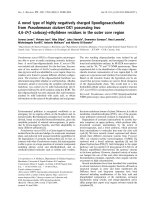Book The Grid Core Technologies - Preface
Bạn đang xem bản rút gọn của tài liệu. Xem và tải ngay bản đầy đủ của tài liệu tại đây (98.58 KB, 14 trang )
Preface
Grid technologies and the associated applications are currently of
unprecedented interest and importance to a variety of commu-
nities. This book aims to outline and describe all of the compo-
nents that are currently needed to create a Grid infrastructure that
can support a range of wide-area distributed applications. In this
book we take a pragmatic approach to presenting the material;
we attempt not only to describe a particular component, but also
to give practical examples of how that software may be used in
context. We also intend to ensure that the companion Web site
has extensive material that can be used by not only novices, but
experienced practitioners too, to learn or gather technical material
that can help in the process of understanding and using various
Grid components and tools.
PURPOSE AND READERSHIP
The purpose of this book is not to convince the reader that one
framework, technology or specification is better than another;
rather its purpose is to expose the reader to a wide variety of what
we call core technologies so that they can determine which is best
for their own use.
This book is intended for postgraduate students and researchers
from various fields who are interested in learning about the core
technologies that make up the Grid today. The material being
developed for the companion Web site will supplement the book’s
content. We intend that the book, along with Web content, will
provide sufficient material to allow a complete self-study course
of all the components addressed.
The book takes a bottom-up approach, addressing lower-level
components first, then mid-level frameworks and systems, and then
finally higher-level concepts, concluding by outlining a number of
xvi PREFACE
representative Grid applications that provide examples of how the
aforementioned frameworks and components are used in practice.
We cover the core technologies currently in Grid environments
to a sufficient depth that readers will be prepared to take on
research papers and other related literature. In fact, there is often
sufficient depth that a reader may use the book as a reference of
how to get started with a particular Grid component.
The subject material should be accessible to postgraduates and
researchers who have a limited knowledge about the Grid, but
technically have some knowledge about distributed systems, and
experience in programming with C or Java.
2. OGSA and WSRF
3. The Semantic Grid and Autonomic Computing
4. Grid Security
5. Grid Monitoring
6. Grid Scheduling and Resource Management
7. Workflow Management for the Grid
8. Grid Portals
9. Grid Applications – Case Studies
System
Infrastructure
Basic Services
Job Management and
User Interaction
Applications
Figure P.1 Organization of the book
PREFACE xvii
ORGANIZATION OF THE BOOK
The organization of the book is shown in Figure P.P.1. We have
organized the book into four general parts, which reflect the
bottom-up view that we use to address the topics covered. We
know that certain topics have been discussed under different parts,
but we feel that this should assist the reader label topics more
easily and hopefully help them get to grips with the content more
easily.
The first section, “system infrastructure”, contains the chap-
ters that discuss and outline the current architecture, services and
instantiations of the Grid. These chapters provide the underpin-
ning information that the proceeding chapters build on. The sec-
ond section, “basic services”, contains the chapters that describe
Grid security and monitoring. Both these chapters explain services
that do not actually need to exist to have a Grid environment, but
without security and monitoring services it is impossible to have a
secure, robust and reliable environment that can be used by higher-
level services and applications. The third section we have labelled
“Job management and User interaction”. At this level users have
potentially direct access to tools and utilities that can change their
working environment (in the case of a Portal), or manage and
schedule their jobs (in the case of workflow and scheduling sys-
tems). Finally, the last section of the book is called “Applications”;
here we discuss a number of representative Grid-based applica-
tions that highlight the technologies and components discussed in
the earlier chapters of the book.
Acknowledgements
This first edition of our textbook was prepared during mid–late
2004, when the Grid-based technologies were not only at an embry-
onic stage, but also in a great state of flux. With any effort, such as
writing a book, nothing would really be accomplished in a timely
fashion without the aid of a large number of willing helpers and
volunteers. The technology landscape that we have been writing
about is changing rapidly, so we sought and asked experts in var-
ious fields to read through and comment on all parts of the book.
We would like to thank the following people for reviewing parts
of the book:
•
Chapter 2 – OGSA and WSRF: Stephen Pickles and Mark
McKeown (Manchester Computing, University of Manchester)
and Helen Xiang (DSG, University of Portsmouth).
•
Chapter 3 – The Semantic Grid and Autonomic Computing:
Rich Boaks (DSG, University of Portsmouth) and Manish
Parashar (Rutgers, The State University of New Jersey, USA).
•
Chapter 4 – Grid Security: Alistair Mills (Grid Deployment
Group, CERN).
•
Chapter 5 – Grid Monitoring: A special thank you to Garry Smith
(DSG, University of Portsmouth), who provided a lot of detailed
content for this chapter, and still managed to write and submit
his PhD.
•
Chapter 6 – Grid Scheduling and Resource Management:
NG1 – Fritz Ferstl (Sun Microsystems), Condor – Todd Tannen-
baum (Condor project, University of Wisconsin, USA), LSF –
Songnian Zhou (Platform Computing Inc, Canada), PBS – Bob
Henderson (Altair Grid Technologies, USA).
•
Chapter 7 – Workflow Management for the Grid: Omer Rana
(Cardiff University).









